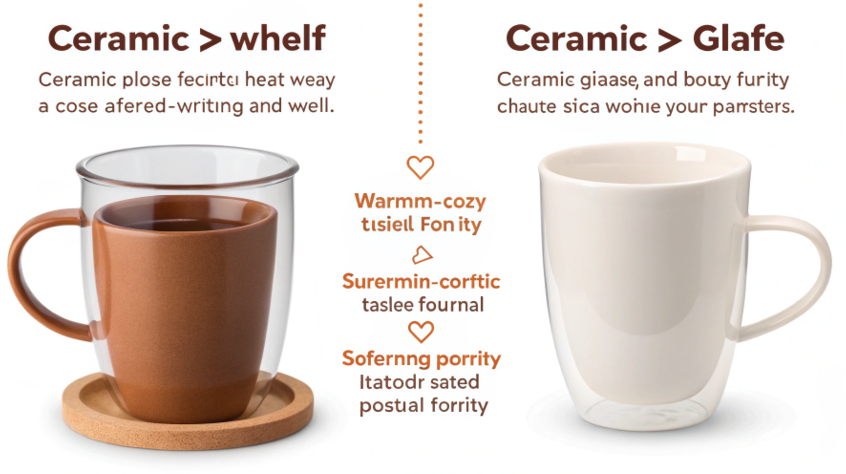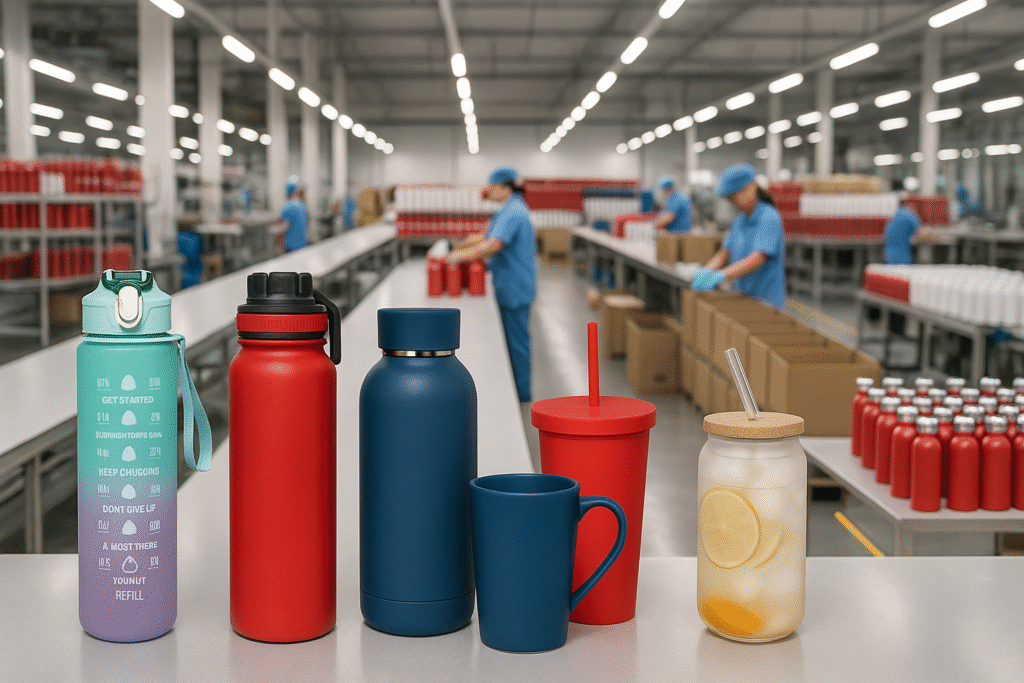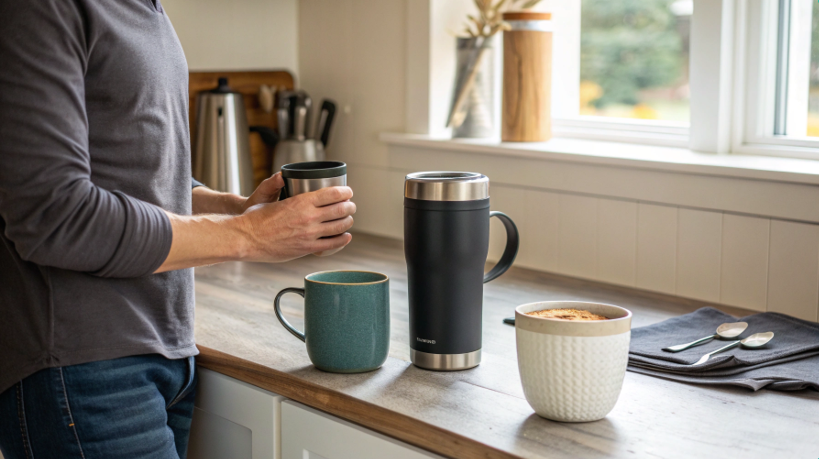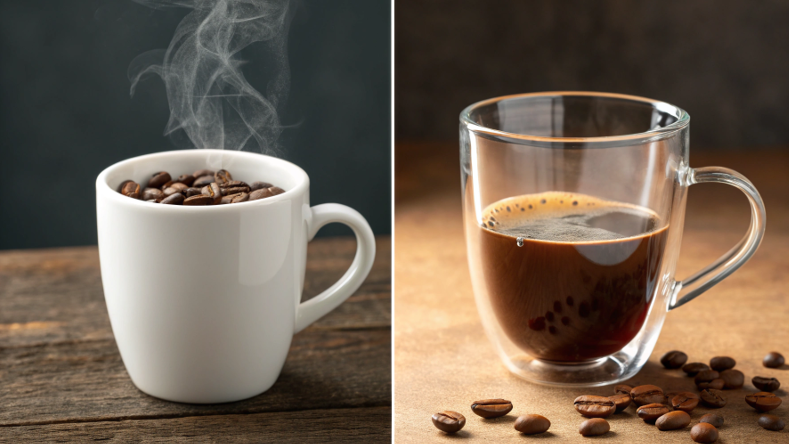Are your customers complaining that their coffee gets cold too fast? This reflects poorly on your product's quality. Choosing the right mug material is the key to delivering a better experience.
Ceramic mugs generally keep coffee hotter longer than glass mugs. This is because ceramic is more porous and a poorer conductor of heat than glass. Its structure slows down the transfer of heat from the coffee to the outside air, keeping your drink warmer.
I’ve spent years in the drinkware industry, from product development to founding my brand, Vivimug. This question—glass versus ceramic—is one I've tackled with countless partners. It seems simple on the surface, but the choice has real consequences for customer satisfaction and brand perception. For a product developer like Emily Chen, understanding the "why" behind heat retention is critical. It's not just about what looks good; it's about what performs best for the user. Let's break down the science and the practical factors so you can make an informed decision for your next product line.
What type of mug keeps coffee hot the longest?
Trying to select the best mug material for heat retention? The options can be overwhelming, and a wrong choice can lead to customer complaints about lukewarm coffee, hurting your brand's reputation.
Vacuum-insulated stainless steel mugs keep coffee hot longest, for hours on end. Among traditional materials, a thick-walled ceramic mug is the best choice. It provides better insulation than glass due to its porous nature, which slows heat loss more effectively.
!
The ability of a mug to keep coffee hot comes down to physics—specifically, how well it prevents heat transfer. Heat escapes your coffee in three ways: conduction (through the material itself), convection (from the liquid's surface to the air), and radiation. A good mug minimizes all three. When I'm working with clients, I explain that the material is the first line of defense against conduction. This is where we see the biggest differences. While advanced technology gives one material a clear edge, traditional materials still have their place. Let's look at how the most common options stack up.
Heat Retention Performance by Mug Type
| Mug Type | Heat Transfer Principle | Typical Heat Retention | Best Use Case |
|---|---|---|---|
| Vacuum-Insulated Stainless Steel | The vacuum layer between the walls stops almost all conduction and convection. | 4-8+ hours | Commuting, travel, long work sessions. |
| Double-Walled Glass/Ceramic | A pocket of air between two walls acts as an insulator, slowing conduction. | 1-2 hours | At a desk or for a leisurely drink where you want more time than a standard mug offers. |
| Single-Walled Ceramic | The material itself is a poor conductor of heat (an insulator). | 30-60 minutes | The classic choice for home or office use; a perfect balance of feel, cost, and performance. |
| Single-Walled Glass | The material is a better conductor of heat than ceramic, so it transfers heat away faster. | 20-40 minutes | Best for visual appeal, like for lattes or teas, where drinking time is shorter. |
For a product developer, this means the choice depends entirely on the product's intended purpose. If the goal is maximum performance, stainless steel is the only answer. If the goal is a classic home or office mug, ceramic is the most practical and effective choice.
Does ceramic hold heat longer than glass?
You're deciding between classic ceramic and modern glass for your new mug line. They offer very different aesthetics, but you can't ignore performance. Which material will keep your customers' coffee warmer?
Yes, ceramic holds heat longer than glass. The porous and less dense structure of ceramic makes it a natural insulator, slowing the rate of heat loss. Glass is denser and non-porous, allowing heat to conduct away from the coffee much more quickly.

The difference in performance comes from the microscopic structure of each material. Ceramic is made from clay that is fired in a kiln. Even after glazing, the material itself contains tiny air pockets. These pockets disrupt the flow of heat, acting as insulation. The thicker the ceramic wall, the more effective this insulation becomes. Glass, on the other hand, is an amorphous solid. Its molecules are packed together more tightly and uniformly, creating a clear path for heat to travel through. This property, known as thermal conductivity, is higher in glass than in most ceramics.
I once worked with a brand developing a line for high-end coffee shops. They loved the sleek look of glass mugs for their cappuccinos. But after we ran a simple side-by-side test—just pouring hot water into both and timing the temperature drop—the results were clear. The coffee in the glass mug became lukewarm almost twice as fast. They ultimately chose a custom-designed ceramic mug to ensure their customers could enjoy their premium coffee at the right temperature.
Ceramic vs. Glass: Heat Retention Properties
| Property | Ceramic | Glass | Implication for Heat Retention |
|---|---|---|---|
| Thermal Conductivity | Lower | Higher | Ceramic slows heat transfer better. Glass pulls heat away from the coffee faster. |
| Porosity | Higher (more air pockets) | None (amorphous structure) | The trapped air in ceramic acts as a natural insulator, slowing heat loss. |
| Typical Wall Thickness | Generally Thicker | Generally Thinner | Thicker walls provide a longer path for heat to travel, further insulating the liquid. |
For a brand, this means that while glass offers a unique aesthetic, ceramic delivers a better functional experience for hot beverages.
What is the most environmentally friendly reusable water bottle?
Choosing the right material for a product line is tough. You're balancing cost, aesthetics, and sustainability. Every material has pros and cons, making it hard to declare one clear winner for the environment.
The most environmentally friendly reusable bottle is the one you use the longest. While stainless steel and glass have strong eco-credentials due to their durability and recyclability, the best choice depends on balancing the manufacturing impact with the product's lifespan and end-of-life options.

In all my years helping clients develop drinkware lines, this question comes up constantly. The answer isn't simple. The "best" material isn't just about what it's made of. It's about its entire life story, from creation to disposal. A product developer like Emily needs to weigh these factors carefully. Each popular material has a different profile. The key is to understand the trade-offs. For example, stainless steel has a high energy cost to produce, but its durability means it can last for decades, making its overall environmental impact very low when used consistently.
Let’s break down the key materials to help you make a strategic choice for your brand.
Comparing Eco-Friendly Reusable Bottle Materials
| Material | Manufacturing Impact | Durability & Lifespan | End-of-Life | Best For |
|---|---|---|---|---|
| Stainless Steel | High. Requires mining iron ore and significant energy to produce. | Very High. Extremely durable, resistant to drops and corrosion. Can last for decades. | Infinitely Recyclable. Can be melted down and reformed into high-quality steel without degradation. | A premium, long-lasting option where durability is the top priority. |
| Glass | Moderate. Made from sand, a plentiful resource. Requires high heat for manufacturing. | Moderate. Can break if dropped. Borosilicate glass is more durable. Lifespan depends on user care. | Infinitely Recyclable. Easily melted down and remade into new glass products. | Purity of taste and a clean aesthetic on a product that will be handled with some care. |
| BPA-Free Plastic (e.g., Tritan) | Low. Lighter weight and requires less energy to produce and transport than steel or glass. | Good. Resists shattering and is very lightweight. Can become scratched or clouded over time. | Difficult to Recycle. Most curbside programs do not accept these plastics, often ending up in landfill. | Lightweight, budget-friendly options for sports or on-the-go use. |
My experience tells me this: focus on longevity. A stainless steel bottle's high initial footprint is offset by its long life. If it replaces 5,000 plastic bottles over a decade, its overall impact is tiny. The most sustainable choice is the one that fits a user's lifestyle so well that they use it for years.
What is the best container to keep coffee hot?
Defining the "best" container is difficult because it depends entirely on the situation. This can be confusing for product development, as a single "best" solution simply doesn't exist for every customer.
The best container matches the user's needs. For travel and maximum heat retention, a vacuum-insulated stainless steel tumbler is best. For enjoying coffee at home or in an office, a thick-walled ceramic mug is often preferred for its classic feel.

The key to developing a successful product is to stop searching for one perfect container and instead think about the perfect container for a specific person in a specific moment. As a product developer, your first question should be: "Who is using this, and where?" The needs of a daily commuter are completely different from someone enjoying a lazy Sunday morning at home. At Vivimug, I guide my partners to think through these user scenarios first, because the right product choice flows from there. Instead of asking "What's best?", we ask "What's best for them?". This approach helps you build a product line that connects with real-world needs.
Let's break down some common scenarios to see how the "best" choice changes.
Choosing the Best Container by Use Case
| Use Case | Customer Need | "Best" Container Choice | Why It's the Best Fit |
|---|---|---|---|
| The Daily Commute | Hours of heat retention, spill-proof lid, durability, fits in a vehicle cupholder. | Vacuum-Insulated Stainless Steel Tumbler | It is specifically engineered for this purpose. It keeps coffee hot for the entire journey and beyond. |
| At the Office Desk | Good heat retention for about an hour, stable base, comfortable to hold, professional look. | Thick-Walled Ceramic Mug | It provides a comforting, traditional coffee-drinking experience and keeps the drink warm long enough for sipping while working. |
| Weekend Morning at Home | Focus on experience: feel, aesthetics, purity of taste. Heat retention is less critical. | Double-Walled Glass Mug or High-Quality Ceramic Mug | The visual beauty of a layered coffee in a glass mug or the comforting weight of a ceramic mug enhances the ritual. |
| Outdoor & Camping | Extreme durability, lightweight, decent insulation against cold air. | Enameled Steel or a Stainless Steel Camp Mug | It must be practically unbreakable and provide reliable performance in a rugged environment. |
As you can see, "best" is a moving target. The goal is not to find a single champion but to build a portfolio of solutions that serve different customer needs perfectly.
Conclusion
For traditional mugs, ceramic keeps coffee hot longer than glass. For maximum performance, nothing beats vacuum-insulated stainless steel. Always choose the material that best fits your customer's daily life and needs.




